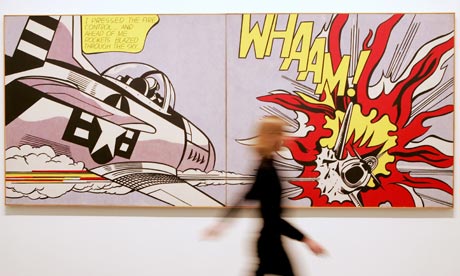History of art: a degree for the elite?
For too long the study of art has been dismissed as a pastime for the well-heeled. This stereotype is unfair and outdated

History of art: out of reach for most students? Photograph: Toby Melville/Reuters
Art. A word that has sat on a gleaming plinth and peered down at
us mere mortals for centuries. In the past, the study of art was
reserved for the wealthy and educated. Even today, galleries have become
an elitist haven for the middle-classes.
Understandably many people go through life purposefully avoiding this terrifying creature, perhaps annoyed by its pretentiousness, or scared off by the people who appear to understand its cryptic language. Whether it's rich aristocrats lounging in gilt frames, or abstract canvases sitting mutely on white washed walls, art can leave us baffled, bemused and squirming under its superior gaze.
As a history of art student at Cambridge University, I have had direct experience of the stigma attached to the subject. I am regularly confronted with the attitude that, as one recent Cambridge graduate put it: "History of art is a niche subject, one that isn't particularly relevant or useful for future life."
The public and students alike regard it as a subject reserved for wealthy students from top private schools. This belief has become a self-fulfilling prophecy. As a student who came to the subject from a state school background, I am in the minority.
The subject's elitist image has been exacerbated by the long list of royals who have studied it – Prince William, Kate Middleton and Princess Beatrice to name a few. This not only gives the impression that you have to be from the right background to study it, but also reinforces the notion that this subject is not useful in the current barren landscape of graduate recruitment.
In 2011 25 people from state schools and 38 from independent schools applied for history of art at Cambridge University. Just five of the available 16 places were awarded to state school students. Admissions tutors have to select the best applicants. These are most likely to be those who visited art galleries when they were children. They will also be those who studied the subject at A-level, something often only offered by private schools.
But strip history of art of its seemingly pretentious finery and it's clear that it's anything but elitist. In my three years at university I have discovered that art is one of the most vivid ways of viewing history — it is an intimate glimpse into someone's world.
Art has traced many of the sociological changes that have occurred throughout history, all through the eyes of real people. Studying it stretches your analytical and interpretive abilities. And while course content may not be directly related to the average graduate job, this is the case with many degrees, especially humanities subjects. The study of art shouldn't have to carry the weight of a stereotype created so long ago.
Understandably many people go through life purposefully avoiding this terrifying creature, perhaps annoyed by its pretentiousness, or scared off by the people who appear to understand its cryptic language. Whether it's rich aristocrats lounging in gilt frames, or abstract canvases sitting mutely on white washed walls, art can leave us baffled, bemused and squirming under its superior gaze.
As a history of art student at Cambridge University, I have had direct experience of the stigma attached to the subject. I am regularly confronted with the attitude that, as one recent Cambridge graduate put it: "History of art is a niche subject, one that isn't particularly relevant or useful for future life."
The public and students alike regard it as a subject reserved for wealthy students from top private schools. This belief has become a self-fulfilling prophecy. As a student who came to the subject from a state school background, I am in the minority.
The subject's elitist image has been exacerbated by the long list of royals who have studied it – Prince William, Kate Middleton and Princess Beatrice to name a few. This not only gives the impression that you have to be from the right background to study it, but also reinforces the notion that this subject is not useful in the current barren landscape of graduate recruitment.
In 2011 25 people from state schools and 38 from independent schools applied for history of art at Cambridge University. Just five of the available 16 places were awarded to state school students. Admissions tutors have to select the best applicants. These are most likely to be those who visited art galleries when they were children. They will also be those who studied the subject at A-level, something often only offered by private schools.
But strip history of art of its seemingly pretentious finery and it's clear that it's anything but elitist. In my three years at university I have discovered that art is one of the most vivid ways of viewing history — it is an intimate glimpse into someone's world.
Art has traced many of the sociological changes that have occurred throughout history, all through the eyes of real people. Studying it stretches your analytical and interpretive abilities. And while course content may not be directly related to the average graduate job, this is the case with many degrees, especially humanities subjects. The study of art shouldn't have to carry the weight of a stereotype created so long ago.
No comments:
Post a Comment